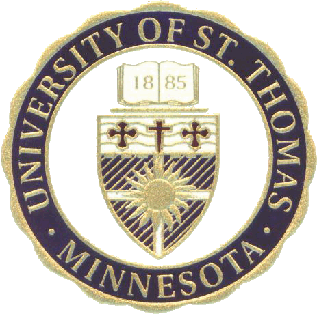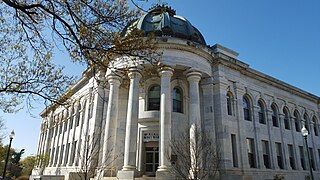Murphy Hall
Murphy Hall opened in 1940 and has been used to house the University of Minnesota's Hubbard School of Journalism and Mass Communication (HSJMC) since that time. The building, which cost $250,000 to build, was funded largely through a fund bequeathed by William J. Murphy. [3] Journalism, advertising and public relations courses are currently taught in the hall at the undergraduate, graduate and doctorate levels. The building features a journalism lab and library. It is located at 206 Church St. SE, Minneapolis, MN 55455 on the Northrop Mall area of the University of Minnesota's East Bank campus.
| U of M Hubbard School of Journalism and Mass Communication | Murphy Hall |
|---|
| Founded: 1922 | Built: 1940 |
| Enrollment: Approx. 1,085 undergrad, 75 grad | Size: 27,000 sg. ft, five floors |
| Courses: Journalism, strategic communication: advertising and public relations, media and information | Cost to build: $250,000 |
| Director: Elisia L. Cohen | Named for: William J. Murphy, former publisher of the Minneapolis Tribune |
Original building
Classes were first held in Murphy Hall during the winter quarter of 1940. The original building had four floors, housed multiple laboratories and was the home of the Minnesota Daily, the Ski-U-Mah, the Gopher and the Literary Review. The chairman of the department at the time was Ralph D. Casey, who served in that capacity for over 30 years. The journalism department itself was founded on campus in 1922 but was housed in various locations across campus, including Folwell and Pillsbury Halls and the old Music Building. Before becoming an official department, journalism classes were offered occasionally on the St. Paul campus through the agriculture school. [4] Floor plans for the original Murphy Hall called for advertising, radio, typography, editing and reporting laboratories, as well as an auditorium, a seminar room and a museum. Plans to connect to nearby Vincent Hall were also laid out. William Murphy, a former publisher of the Star Tribune newspaper, left an interest-collecting fund for the soon-to-be-established department in 1918, citing a desire toward “the establishing and maintaining of a course of instruction in journalism.” [4] Twenty-two years later, the gift paid for 55 percent of construction costs. The remaining funds came from a grant and student publications.
1999 renovation
Murphy Hall underwent its first substantial update at the end of the 20th century, when most of the building's interior was gutted and renovated. The $9.25 million project [5] started in 1999 and was completed in April 2001. A new auditorium, conference center and library were added, as were new classrooms and a broadcast studio. Mark Yudof, the University president at the time, said the renovation was, "...a jumping off point for new directions and innovations. It is all very exciting. It's catapulted the journalism school back to greatness..." [5] The original stairwells, which featured opaque glass block windows, were retained, as was the Heggen Room, which had previously served as the school's library. The exterior of the building was also left intact. Students were able to take journalism classes during the two-year renovation but were moved to nearby classrooms. [6]
Modern building
Murphy Hall today is 27,000 square feet (2,500 m2) in total, [5] encompassing five floors. The redesigned basement now features the Eric Sevareid Library, named after the former CBS broadcast journalist and SJMC alum (B.A. 1935), and a digital resource lab. The library features a selection of magazines and newspapers from across the country, trade-related journals and books, study areas and eight computers for student use. The lab has 52 computers for student use, video equipment for checkout and a recording studio, as well as areas for lectures. On the first floor, there is a 148-seat auditorium and various offices, including the student services office. The second and third floors house classrooms, faculty offices and areas for research. The fourth floor is home to the Silha Center for the Study of Media Ethics and Law, [7] named after SJMC alum Otto Silha (B.A. 1940). The center, which has been around since 1984, is directed by Jane Kirtley. As planned for in 1939, Murphy Hall connects with Vincent Hall, the nearby math building, via multiple skyways and a tunnel. Between the two buildings and underneath part of the walkway is a courtyard, which features seating and a small fountain. As of 2007, the Minnesota Daily, one of the nation's largest student-run newspapers and the fourth-largest paper in Minnesota, no longer has an office in Murphy Hall, though many of its employees take journalism classes in the building.

Augsburg University is a private university in Minneapolis, Minnesota. It is affiliated with the Evangelical Lutheran Church in America. It was founded in 1869 as a Norwegian-American Lutheran seminary known as Augsburg Seminarium. Today, the university enrolls approximately 3,000 undergraduate and 800 graduate students. Augsburg is known for its emphasis on service learning; volunteering in the community is both an instructional strategy and a required part of a student's coursework.

Metropolitan State University is a public university in the Minneapolis–St. Paul, Minnesota metropolitan area. It is a member of the Minnesota State Colleges and Universities system.

The University of St. Thomas is a private Catholic research university with campuses in St. Paul and Minneapolis, Minnesota. Founded in 1885 as a Catholic seminary, it is named after Thomas Aquinas, the medieval Catholic theologian and philosopher who is the patron saint of students. As of fall 2021, St. Thomas enrolled 9,347 students, making it Minnesota's largest private, nonprofit university.

Drake University is a private university in Des Moines, Iowa, United States. The University offers over 140 undergraduate and graduate programs, including professional programs in business, education, law, and pharmacy. Drake University Law School was founded in 1865, which makes it one of the 25 oldest law schools in the United States.

Hamline University is a private university in Saint Paul, Minnesota, United States. Founded in 1854, Hamline is the oldest university in Minnesota, the first coeducational university in the state, and is one of five Associated Colleges of the Twin Cities. The university is named after Bishop Leonidas Lent Hamline of the United Methodist Church. As of 2017, Hamline had 2,117 undergraduate students and 1,668 graduate students.

Arizona State University at the West Valley campus is a public university in Phoenix, Arizona. It is one of five university campuses that compose Arizona State University (ASU). The West Valley campus was established by the Arizona Legislature in 1984, and is located in northwest Phoenix, bordering the city of Glendale.

Arnold Eric Sevareid was an American author and CBS news journalist from 1939 to 1977. He was one of a group of elite war correspondents who were hired by CBS newsman Edward R. Murrow and nicknamed "Murrow's Boys." Sevareid was the first to report the Fall of Paris in 1940, when the city was captured by German forces during World War II.

Franklin Pierce University is a private university in Rindge, New Hampshire, United States. It was founded as Franklin Pierce College in 1962, combining a liberal arts foundation with coursework for professional preparation.

Massachusetts College of Art and Design, branded as MassArt, is a public college of visual and applied art in Boston, Massachusetts. Founded in 1873, it is one of the nation's oldest art schools, the only publicly funded independent art school in the United States. It was the first art college in the United States to grant an artistic degree.
University of the West (UWest) is a private Buddhist university in Rosemead, California. It was founded in 1990 by Hsing Yun, founder of the Taiwan-based Buddhist order Fo Guang Shan and Hsi Lai Temple, the North American order headquarters. The school offered its first class in spring of 1991.

The Gaylord College of Journalism and Mass Communication is the journalism unit of the University of Oklahoma in Norman. The college is named for the former longtime publishers of The Oklahoman.

The School of Communication (SOC) is American University's school of mass communication, media studies and journalism, founded originally as the Department of Communication in 1893 with the founding of the university. It is accredited by the Accrediting Council on Education in Journalism and Mass Communications.

The Walter Cronkite School of Journalism and Mass Communication, is one of the 24 independent schools at Arizona State University and is named in honor of veteran broadcast journalist Walter Cronkite. The school, which is located at the downtown Phoenix campus, offers several undergraduate and graduate programs in journalism, and in fall 2011, launched its first doctoral program in journalism and mass communication.

The University of Notre Dame School of Architecture was the first Catholic university in America to offer a degree in architecture, beginning in 1898. The School offers undergraduate and post-graduate architecture programs.
The Bachelor of Journalism (B.J.) degree is a degree awarded at some universities to students who have studied journalism in a three or four year undergraduate program. In the United States, some schools that do not award the B.J. degree instead confer a Bachelor of Arts, Journalism (B.A.J.), Bachelor of Arts in Journalism and Mass Communication (B.A.J.M.C.) or Bachelor of Science, Journalism (BSJ) that is often part of or in conjunction with a course of study in mass communication. Yet another epithetological version of the degree, conferred by The Henry W. Grady College of Journalism and Mass Communication at the University of Georgia, is the A.B.J. degree, the Latin equivalent of the B.J./B.A.J.
The Edward R. Murrow College of Communication is a college of Washington State University (WSU) named in honor of one of WSU's most famous alumni, Edward R. Murrow. The college was launched July 1, 2008. Previously it was the Edward R. Murrow School of Communication housed in the College of Liberal Arts. The Murrow College offers undergraduate sequences in Communication & Society, Journalism & Media Production, and Strategic Communication. The College offers emphases in Communication, Technology, & Social Influence and Media & Health Promotion at the graduate level. The Murrow College currently has 35 faculty, 584 undergraduate students and 30 graduate students.
The College of Communication & Information is the communications, information, and media unit at the University of Kentucky. The college offers the following undergraduate majors: Communication, Information Communication Technology, Integrated Strategic Communication, Journalism, and Media Arts and Studies. Graduate programs are offered in Communication, Information Communication Technology, and Library Science. The college has over 1,600 undergraduate students and nearly 300 graduate students pursuing Master's and Ph.D. degrees. It is the only American Library Association accredited program in library and information science in the state of Kentucky.

Veritas University is a private university, located in Abuja. It was founded in March 2002 by the Catholic Church in Nigeria. The Institution received its provisional operation licence in 2007 from the National Universities Commission and commenced admission of students in October 2008, at its take-off campus in Obehie, Abia State, Nigeria.

The Northrop Mall Historic District is a historic district located at the University of Minnesota's east bank campus in Minneapolis, Minnesota. It covers buildings along Northrop Mall and in the surrounding area. The district was found eligible to be listed on the National Register of Historic Places in 2006, and was officially added in January 2018. Most of the buildings are connected by the Gopher Way; a tunnel and skyway network providing easy and direct enclosed pedestrian access. The district is roughly bounded by Pillsbury Drive SE to the north, East River Parkway to the west, Union Street SE to the east, and Delaware Street SE to the south. It is located directly south of the university's Old Campus Historic District.















